-
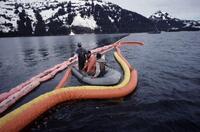
Photograph of the clean-up of the Exxon Valdez oil spill. Taken by Paul Fusco.
-

Director Andrew Stanton follows the life of a clownfish named Marlin who lost his son Nemo. The film moves from the Great Barrier Reef to a dentist's office in Sydney. There are adventures and run-ins with sharks, sea turtles, and jellyfish. This animated children's film symbolizes the beauty of the ocean along with the connection of family.
-
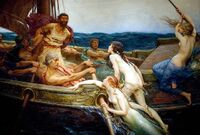
A painting by Herbert James Draper depicting a scene from the Odyssey where Ulysses is being tormented by sirens as he is tied down to the mast of his ship. As the sirens are climbing the boat, they lose their fish-like features and are depicted as nude women using their seductiveness to lure Ulysses into danger.
-
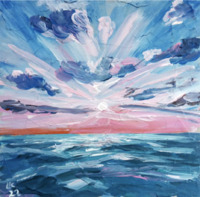
Artwork by Lada Kholosho from Estonia portraying the pinkish beams of the sun shining over the ocean as it rises and sets. Painted with broad brushstrokes and limited blending, this painting portrays the simple beauty of the ocean. It shows how often we have to look beyond the complex to find the beauty that is simply there in front of us in nature, specifically in the ocean.
-
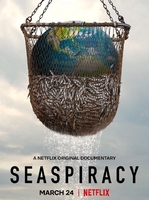
-
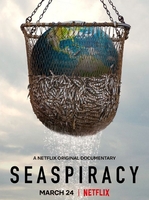
-
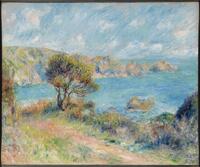
Artwork by Pierre-Auguste Renoir depicting the French island's most picturesque viewpoint overlooking the bay's rocky coastline. This scene depicts a place of pure serenity, the perfect place for a long romantic walk or a picnic with a quick dip in the water. His painting creates a sense of calm happiness which is amplified by his loose brushstrokes.
-
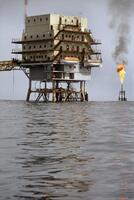
This is a color photograph of an offshore oil rig in Gabon. Taken by Bruno Barbey.
-
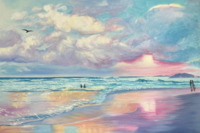
This piece by Olga Astri from Kazakhstan plays with the idea of an ocean in a relaxing dreamscape. The pastel colors used in this painting combined with Astri's blurred technique bring a sense of nostalgia to the viewer in a fantastical sense. Astri's skillful use of white specks upon the waves aids to the glittery nature of water which can closely be related to the sun reflecting upon a calm ocean day. The vibrant oranges, pinks, and blues of the sky mirroring upon the wet, ocean-washed, sand seamlessly capture the realistic yet ethereal view of this beach. The ideal picturesque nature of this painting is immediately noticed by the perfectly positioned seagull in the corner and the civilians admiring the sunset on the beach and in the water. This setting perfectly captures the joy, beauty, and relaxation that a culmination of ocean experiences can bring to one's imagination.
-
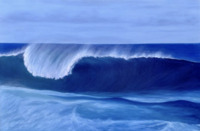
Artwork by Alla Kallass depicts the great waves seen by the powerful storms in Canada, where she lives. Originally a teacher, Alla Kallass finds joy in painting the nature that inspires her. This oil painting is a seascape, focusing on one big wave and its strong crash. The ocean inspires her, its colors and shades of blue bring her happiness. The vastness and strength of the ocean during a storm are often considered an inspiring symbol of nature's power.
-

Sculpture made from a sea of plastics (comprised of over 100,000 single use plastic bottles).
Artist: Sue Lipscombe
-
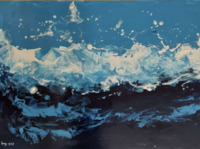
This piece by Sartika Mohomad is an abstract piece from Indonesia, inspired by the crystal yet warped nature of water. When looking at this piece, the viewer is almost transported to the position under the water, looking up through the flip side of the water's surface up to the sky. This painting evokes feelings of nostalgia within the viewer, bringing a sense of familiarity possibly experienced during their childhood days. Mohomad draws upon these connections and employs an abstract marbled technique to create the light-warping, optically illusive movement of water from an underwater perspective. This painting not only inspires the viewer through its evocative nature but also is inspired by personal experiences and awe.
-
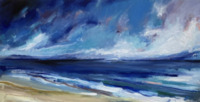
This piece by Nazar Tuvakov is meant to portray the connection of the sky and sea as one entity. Tuvakov skillfully employs blending techniques to incorporate the sky and sea into a unified entity on the canvas, drawing upon the notion that the sky is a continuation of the sea and vice versa. Earth's water is in constant motion, transitioning between the atmosphere and the surface of our planet. In a visual sense, the atmosphere and water are once again connected when one stands at the edge of the ocean, gazing at the horizon. As the ocean follows the natural curvature of our planet, its vast blue expanse blends into the expansive sky, creating a sense of continuity. The reflection of the sky on the water's surface enhances this visual merging, emphasizing the idea of a shared space. This continuity metaphorically represents the unity and interconnectedness within nature, especially highlighting the fluid and dynamic boundaries that elements within nature possess. Tuvakov draws upon these ideals and depicts them literally on this canvas.
-
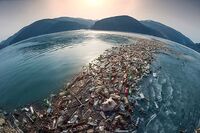
The unfortunate reality of an otherwise beautiful scene.
Image from World Atlas
-
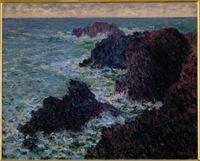
Artwork by Claude Monet otherwise known as The Savage Coast. This is one of the five paintings that Monet produced of the Port-Domois islands. Like many of Monet's works, The Rocks of Belle-Ile was inspired by his fascination with the ocean and its surroundings. Located off the coast of Brittany in the English Channel, Belle-Ile is an island known for its rugged cliffs and dramatic coastal landscapes. During the summer of 1886, Monet visited Belle-Ile and was immediately captivated by the beautiful rugged coastal landscape surrounding the island. This specific painting within the series reflects Monet's fascination with the ocean and his "desire to capture its ever-changing moods and colors." Monet's take on the coastline of Belle-Ile skillfully depicts the interplay of light and shadow on the water as the powerful waves crash into the rocky coastline. His use of vibrant blues, greens, and whites conveys the awe-inspiring vastness, strength, and beauty of the ocean. The Rocks of Belle-Ile stands as a testament to Monet's deep connection with the ocean and his ability to translate its magnificence onto canvas for viewers to experience the same tranquility and power that he witnessed.
-
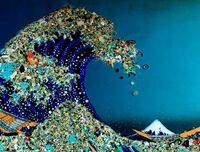
-
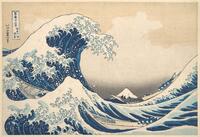
Artwork by Katsushika Hokusai from the series “Thirty-six Views of Mount Fuji”. This is a Japanese style print depicting style from the Edo period of 1615-1868. The Great Wave off Kanagawa is inspired by the vast and beautiful, yet treacherous and destructive power of the ocean. It captures the awe-inspiring force of nature as the colossal tsunami wave looms over the civilians within their Marko-bune-style cargo boats. Hokusai's work is renowned for his ability to capture the movement and energy of the waves. Thus, this print reflects the importance of the ocean in Japanese culture. Japan is composed of approximately 430 inhabited islands. As a result, fishing has remained a vital source for the country's economy, transportation, livelihood, history, and culture. The ocean plays a major role in the daily lives of Japanese people and has profoundly impacted the culture's view of the ocean. It not only symbolizes a life source but also displays the resilience and strength of humanity through their ancestors in the face of natural forces.
-

-

Picture of an Angler Fish
-
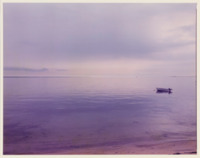
8"x10" photograph by Joel Meyerowitz, American, b. 1938 in the Binghamton University Art Museum Collection
-

A yorkie looking into the abyss and the abyss is looking back
-

A yorkie tilting their head
-

Photograph by Ben Shahn. Features a couple standing in front of a log cabin.






















